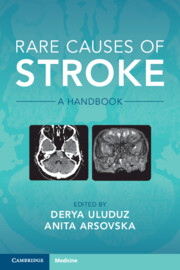Book contents
- Rare Causes of Stroke
- Rare Causes of Stroke
- Copyright page
- Contents
- Contributors
- Preface
- 1 Inflammatory Conditions
- 2 Infectious and Postinfectious Vasculitis
- 3 Hypercoagulable Causes of Stroke
- 4 Drug-Related Stroke
- 5 Hereditary and Genetic Causes of Stroke
- 6 Rare Causes of Cardioembolism
- 7 Vasospastic Conditions and Other Vasculopathies
- 8 Other Non-inflammatory Vasculopathies
- 9 Venous Occlusive Conditions
- 10 Bone Disorders and Stroke
- Chapter 10.1 Bone Disorders
- Chapter 10.2 Eagle Syndrome
- Index
- References
Chapter 10.2 - Eagle Syndrome
from 10 - Bone Disorders and Stroke
Published online by Cambridge University Press: 06 October 2022
- Rare Causes of Stroke
- Rare Causes of Stroke
- Copyright page
- Contents
- Contributors
- Preface
- 1 Inflammatory Conditions
- 2 Infectious and Postinfectious Vasculitis
- 3 Hypercoagulable Causes of Stroke
- 4 Drug-Related Stroke
- 5 Hereditary and Genetic Causes of Stroke
- 6 Rare Causes of Cardioembolism
- 7 Vasospastic Conditions and Other Vasculopathies
- 8 Other Non-inflammatory Vasculopathies
- 9 Venous Occlusive Conditions
- 10 Bone Disorders and Stroke
- Chapter 10.1 Bone Disorders
- Chapter 10.2 Eagle Syndrome
- Index
- References
Summary
Eagle syndrome is caused by elongated/disfigured styloid process, which interferes with the functioning of neighboring structures. It was named after Watt Weems Eagle, who described his first cases in 1937. There are two types of Eagle syndrome:“Classic Eagle syndrome” and “Vascular Eagle syndrome”. It can be caused by compression of cranial nerves, most commonly the glossopharyngeal nerve, with throat and neck pain; compression of the carotid artery which can cause transient ischemic attack/stroke or compression of sympathetic nerves along the artery, leading to symptomsetc. Diagnosis of Eagle syndrome is established based on optimal medical history, physical examination, CT and CT angiography. Management includes conservative and operative treatment. We present a female patient with transient ischemic attack in the carotid system, and later pulsatile tinnitus, caused by carotid dissection and moderate degree stenosis. After extensive investigations, neuroimaging confirmed that the elongated styloid process caused changes in the carotid arteries. Adequate medicamentous therapy was recommended and improvement of the symptoms was noted
- Type
- Chapter
- Information
- Rare Causes of StrokeA Handbook, pp. 343 - 348Publisher: Cambridge University PressPrint publication year: 2022

